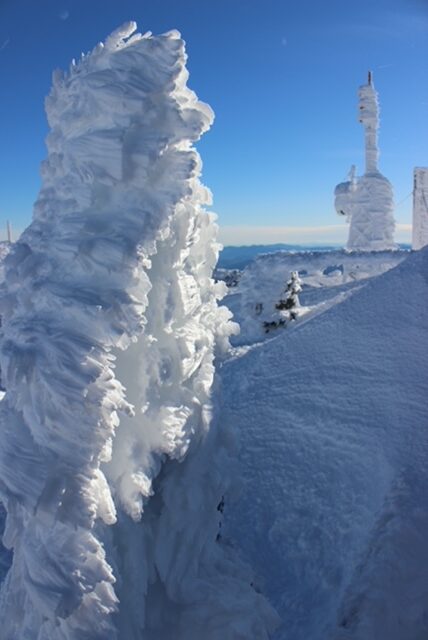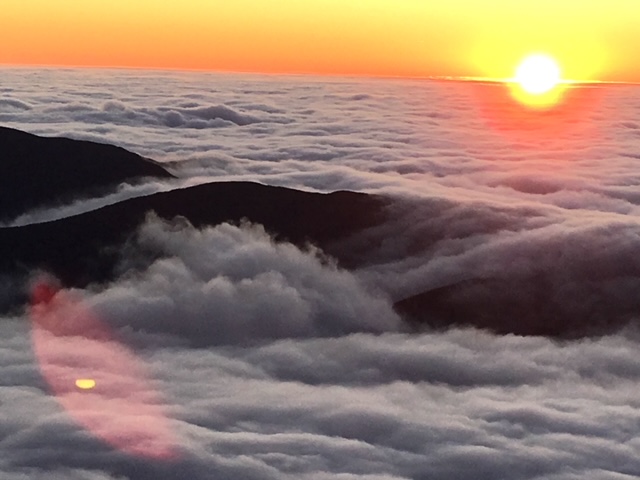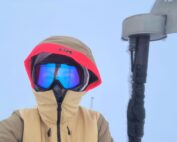Once In a Lifetime Isn’t Enough
By Bill Ofsiany
A once in a lifetime experience is an over-used term. It might apply to seeing a comet that won’t be back to see for 75 years (Halley), or 80,000 years (C/2023 A3). It doesn’t apply to Mount Washington in winter. As Slim Bryant, a former Snowcat driver once told me years ago, “every time you go to the summit it’s a different mountain.” Each time you spend eight days on the summit, with the weather crew, as a summit volunteer, you get to see a little more of the moods, weather events, and natural phenomena, that can’t possibly be squeezed into a single trip.
RIME characterizes Mt. Washington in winter; it forms from supercooled water droplets in fog, blowing over the summit. If it is below freezing, when the droplets hit something, surface tension is broken and the moisture freezes instantly, growing into the wind. Rime can form into animal shapes, like a woodpecker, a bear, elephant or waiting dog. It can form into delicate, clearly defined feathers, even while growing into hurricane force winds. It can grow out four feet or more and fall away in a few hours with above freezing temperatures. If you get up early on a clear morning, it is colored pink or red by alpenglow from the rising sun. Sunlight, even with temperatures below freezing, sublimates the pure white rime into translucent forms. Rime forming in blowing fog is silent, but one of the sounds unique to living on the summit is hearing an observer or intern hitting the metal frame holding the wind instruments on top of the tower to dislodge the rime at fifteen minutes before the hour.
Tink….Tink….Tink, the sounds of metal hitting metal, softly transmits down to the bunk rooms. You smile, knowing it’s a rime day, and also
knowing, even before you open your eyes, that it is not a sunrise morning. Rime ice forms only when the summit is in the clouds.

Photo by Bill Ofsiany
UNDERCAST conditions are equally impressive. On a sunrise morning with undercast, the valleys are all clouded in with the higher summits in the clear. The low angle sun projects a shadow of Mt. Washington on the cloud tops to the west of the summit. Sometimes a rainbow halo, called a “glory” surrounds the summit and tower features as it is projected onto the cloud tops This is called a Brochen Spectre. Other times the undercast makes the peaks to the east and southeast look like islands off the Coast of Maine, the cloud tops looking like water surrounding the islands (the peaks). At other times on undercast days, the clouds reveal the fluid dynamics of the atmosphere. A wave cloud will form over the Southern Presidentials and pour over the summits, down into Dry River, south of the peaks, then swing up onto the Montalban Ridge and explode, like a wave hitting a rock. All this happening in superslow motion, seeming frozen in time.

Photo by Bill Ofsiany
At still other times, row after row of waves march toward the peaks above the clouds. The same fluid dynamics of ocean waves can be seen as the cloud waves rise up and form breakers at the base of the mountains, crashing and splashing up the sides of Wildcat. Like ocean waves moving into shallower water, the wave period gets shorter as the clouds move through Pinkham Notch, buried in the undercast, the space between the wave peaks shorter.
SUNRISES on mornings with 130 mile visibility, you can see the rising sun reflecting off the Atlantic Ocean when the sun first comes over the horizon. Sunrises and sunsets need more than just good visibility. Help is needed in the form of just the right amount of clouds and right type of clouds to express the varied colors in the sunrise. The whole thing becomes a spectacular event. One such morning was crystal clear to the east, with red alpenglow bathing the summit. To the west, the sky was ink black, and rain was falling. A double rainbow formed over the summit. A number nine sunrise, for sure. The lack of celestial music in the background the only thing preventing it from being a perfect ten.
SNOWBOWS form over the Great Gulf like rainbows, only made by light reflected by snow flakes –not refracted by water droplets– and white,
not rainbow colored.
QUAKES—We felt an earthquake in Southern Maine while on the summit, feeling and sounding like thunder. A few minutes later the phone rang in the dining room. Someone on the phone asked if any of the rocks on the summit moved. We were pretty sure some had, but with no observable data, so we answered yes. The next question, “how many of the rocks moved?” We didn’t have the the answer to that. When the still air temperature dips below minus thirty degrees, the building starts making sounds, like seismic noises, as the concrete and rebar anchoring the building to the mountain expands and contracts at different rates because of the wide range in temperature between outside and inside. It sounds like ice expanding on a frozen lake, but reverberates throughout the building.
NIGHT. Billions and billions of stars. Actually, an unaided eye can see about 2,500 stars during the dark of the moon (new moon). From the summit you feel like that number is way too low. During times of peak solar flares, the greens and yellows of the Northern Lights fill up the northern sky on nights when the summit is clear.
HOARFROST—All winter, moisture from the living area gets into the cold tower stairway leading up to the weather room— the “A” frame door, the cold room and the steep stairs leading up to the top of the tower. The moisture forms extensive hoar frost that projects out from the walls and windows. When the warmer, above-freezing weather arrives in April, it starts to rain inside the tower as the frost melts, requiring bailing melt water out of the base of the tower.
GLAZE ICE forms when the temperature on the summit is below freezing and liquid water is coming down, not snow. Ice can form on surfaces like the wind instruments on top of the tower at a rate of three to four inches per hour. Instead of clearing soft rime ice off the tower with a metal rod, the “hammer of Thor” is employed. It is a massive mallot, non-metallic, that is used to break off the ice. Ice chunks the size of rock wall stones litter the area around the tower.
PRESENCE…For as long as there have been observers on the summit–going back to the 19th century–there have been some unusual, hard to explain events. I had one of these experiences a few years ago while taking rime ice photos on a clear, cold, light wind morning. I was down on one knee, photographing rime that had formed in all directions by swirling wind at the base of some rocks on Trinity Height. The rime on the ground was frozen and crunchy. I heard very clearly, footfalls of someone walking up toward where I was kneeling. The steady crunch, crunch, crunch cadence of walking was exactly the sound I made getting to that point. I finished taking pictures and stood up to greet another sunrise watcher. There was no one there; the only tracks in the rime were the ones I made. No one else from the tower was outside and no sunrise summit hikers from the valley.

Bill Ofsiany and Matt Wingate in the kitchen, March 2025.
COOKING is the main job the summit volunteer has. On one trip, the oven died the first day of our stay. We made all of our meals on the stovetop that week, and baked brownies and cakes for dessert in the waffle maker. You get the opportunity to think outside the box.
FASTEST TRIP DOWN was a ten minute turnaround ahead of a huge storm due to hit the area around noon. It’s called a “turn and burn.” We made it down to the base in an hour.
SLOWEST RIDE TO THE SUMMIT was 13 hours in the Snowcat over three days. An October snowstorm had left deep, light, unconsolidated snow drifts high on the mountain. The wind gusting in the 90s easily moved the snow and stirred up clouds of blinding, blowing snow. There was no visibility. We could see the treads of the Snowcat below the side windows churning the loose snow at Cragway, though not moving the machine forward. We were just short of mile 6. It was time to turn around. The second day, we didn’t even get that far. The third day, we finally got to the summit.
These are only some of the stories of volunteering seventeen times, over a thirteen year period, with 136 days on the summit. There are so many more……every time you go up, it is a different mountain.
To read more of Bill Ofsiany and partner Barbara Althen’s volunteer blog posts, click here.
Supporter Spotlight: Ryan Shepard
Supporter Spotlight: Ryan Shepard By Ryan Shepard and Carissa Milliman Ever since I was a kid, living in Western New York and growing up with lake effect snow, I thought harsh weather was incredibly
Supporter Spotlight: Erik Rider
Supporter Spotlight: Erik Rider By Wendy Almeida For Erik Rider, supporting Mount Washington Observatory comes from a lifelong fascination with weather and how it shapes daily life. Growing up along the Massachusetts coast, he
An Autumn Above the Clouds on Mount Washington
An Autumn Above the Clouds on Mount Washington By Cassie Farnsworth I don’t know how many times in life you get to say “it was exactly what I hoped it would be,” but my


